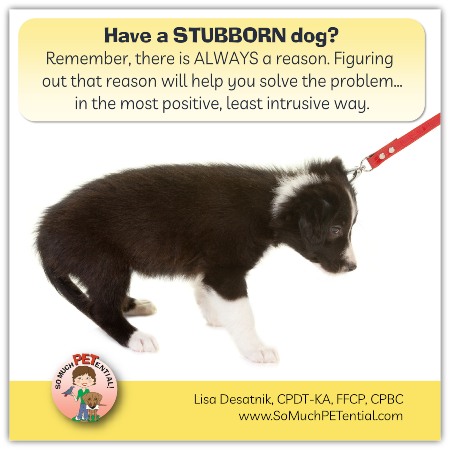I can’t tell you how many times I’ve heard the complaint, “My dog is stubborn.” It seems to be an epidemic among the canine species and apparently it is easily spread from one household, one animal to another. But, it also apparently mutates. A stubborn dog could be one that stays standing or even lunges on the leash when asked to sit. A stubborn dog could be one that continues to sniff a flower or dig in the dirt when being called to come. Or a stubborn dog could be one that puts on the brakes, refusing to move in the direction you are trying to walk. Why is your dog stubborn and what can you do to stop it (at least in that moment)? I’ll talk more about that in this post.
Beyond The Label
 The first thing I will do if you tell me that you have a ‘stubborn’ dog, is ask you, “What exactly does stubborn look like to you and when is it most likely to happen?” After all, stubborn is really just a label or construct. It could describe SO MANY different behaviors in so many different contexts; and what I picture when I think of stubborn could be very off from what you are thinking.
The first thing I will do if you tell me that you have a ‘stubborn’ dog, is ask you, “What exactly does stubborn look like to you and when is it most likely to happen?” After all, stubborn is really just a label or construct. It could describe SO MANY different behaviors in so many different contexts; and what I picture when I think of stubborn could be very off from what you are thinking.
That’s just one of the problems with using labels to define problems. Whatever YOU envision will greatly impact how you go about trying to solve the matter. By thinking of your dog as stubborn, you may totally miss that your dog was trying to avoid something, was in pain or didn’t really know what you wanted him to do.
So, before you go any further, stop using that label. Instead, describe what exactly your pet is doing as observable, measurable behaviors. What is the context of that behavior? In other words, where is it happening? What is going on before, during and after those ‘stubborn’ behaviors? What is the consequence of those stubborn behaviors? The answers to these questions will help you unlock some ideas for behavior change strategies.

Five Possible Reasons For Dog Stubbornness To Consider
Medical Reasons. It could be that your dog is in pain or has another medical issue that makes the behavior you are asking for, difficult to do. Recently, when a client’s dog was not sitting as asked, I noticed that when he did sit, he was falling into it. Tests revealed he had a pulled groin muscle. Maybe your dog isn’t wanting to go further on a walk because something is causing discomfort or tiredness. Definitely if there is a sudden behavior change, rule out any underlying health issue that could be the root cause.
Environmental Factors. It could be that your dog senses or smells something aversive/dangerous from HIS perspective. Animals are always learning from past experience. Maybe the last time you took your dog for a walk in a certain direction, you encountered a growling dog and so your dog does not want to go back there. Maybe the pavement is too hot or cold. Maybe there is way too much external stimulus and you have taken your dog too close; and so, when your dog seems like he is blowing you off, he really is not in a state to process your cues. Maybe when you call your dog to come from outside at 7:00 am, that it means your dog will be locked in his crate for the next four hours. Or maybe when you call your dog to come at the dog park, it means that the fun is being taken away.
Just last night I was outside with a client, observing her walk her dog on the sidewalk. A man came out of his house, rolling his garbage can to the street. Her dog startled and immediately backed up. When my client turned to walk away from the house toward me, her dog was in flight response moving very quickly. The next time they walked in that direction, her dog planted her feet on the ground. In this instance, my client stopped with her dog, pet her dog, dropped some treats and her dog very quickly recovered with loose muscles ready to walk forward again. They walked back and forth on the street several times as her dog continued to show loose muscles and then walked up to the garbage cans (watching for any sign of stress signals from her dog – that did not happen) to sniff them. Had my client just said, ‘my dog needs to stop being stubborn’, she would not have addressed the underlying reason for her dog’s behavior, may have created more stress in her dog and may have increased her dog’s response the next time they encountered a garbage can.
Your dog doesn’t fluently know the behavior you are requesting. If you haven’t practiced doing the behavior to the point of your dog doing it without hesitation, he really may not know what you are asking and may be confused. Please read this post on how you may be inadvertently creating cue competition.
You have actually taught your dog that ‘stubborn’ behavior. It could that you have inadvertently taught your dog that leaning over, lowering your hand AND saying ‘lay’ is the cue for laying down; and so, when you stand there and ask your dog to ‘lay’, he doesn’t understand. Or, maybe when you ask your dog to sit and your dog stands and looks at you, that THEN you pull out a treat and lure him into a sit. You are reinforcing your dog for standing and looking at you when you say ‘sit’.
So, you’ve got a ‘stubborn’ dog. What can you do to make changes?
Always know there is ALWAYS a reason for behavior. Your dog is not just being ‘stubborn’ for the sake of getting under your skin or trying to be dominate.
If there is a medical reason, that should be addressed first.
Listen to your dog. Get to know your dog’s body language. Watch for stress signals. If your dog does not want to walk in a certain direction, don’t force the issue. If your dog is afraid of something, help your dog to feel safe. You can walk the other direction or choose another location all together. You may need to work on teaching your dog new associations with environmental stimulus. If what you are doing is causing your dog to exhibit stress signals, change how you are interacting.
Always teach your dog with the most positive strategies, allowing for choice, as much as possible. Teach your dog that good things happen when he does wanted behaviors.
Modify how you are training your dog. You may need to back up steps, work in an environment with less competing reinforcers, break the lesson down into smaller steps, change your posture, for example.
Keep in mind that consequences matter. Your dog is going to do things that get him stuff he values. This means, of course, that it is important to know what YOUR dog values. Every animal is an individual and those values can change during the course of a day.
Find a trainer who uses the most positive strategies to help you…and your dog.







